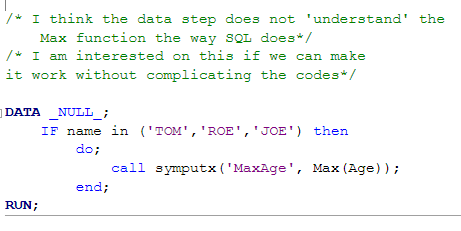- Home
- /
- Programming
- /
- Programming
- /
- Data step-Max Function
- RSS Feed
- Mark Topic as New
- Mark Topic as Read
- Float this Topic for Current User
- Bookmark
- Subscribe
- Mute
- Printer Friendly Page
- Mark as New
- Bookmark
- Subscribe
- Mute
- RSS Feed
- Permalink
- Report Inappropriate Content
A data set is given below.
Name Age
Jack 10
Joe 31
Tom 22
Roe 33
Rex 44
Tim 24
In a single step I am trying to find the person with maximum age from the individuals named Tom , Row and Joe.
Thanks
Accepted Solutions
- Mark as New
- Bookmark
- Subscribe
- Mute
- RSS Feed
- Permalink
- Report Inappropriate Content
You don't have to involve Macro variables, because if you do, it generally means more than ONE steps.
data have;
input Name $ Age;
cards;
Jack 10
Joe 31
Tom 22
Roe 33
Rex 44
Tim 24
;
/*OEN STEP SQL*/
proc sql;
select * from have where upcase(name) in ('TOM','ROE','JOE') HAVING AGE=MAX(AGE);
QUIT;
/*ONE STEP DATASTEP*/
DATA WANT;
SET HAVE (WHERE=(UPCASE(NAME) IN ('TOM','ROE','JOE'))) END=LAST;
LENGTH _N $20.;
RETAIN _N _A;
IF _A<AGE THEN DO; _A=AGE; _N=NAME;END;
IF LAST THEN DO; AGE=_A;NAME=_N;OUTPUT;END;
DROP _:;
RUN;
Haikuo
- Mark as New
- Bookmark
- Subscribe
- Mute
- RSS Feed
- Permalink
- Report Inappropriate Content
Sounds like a homework assignment. Try to solve it and, if you run into a problem, post your attempted code.
- Mark as New
- Bookmark
- Subscribe
- Mute
- RSS Feed
- Permalink
- Report Inappropriate Content
Will be doing something like this for my project coming soon. Looking at my data, I am trying to figure out the candidate codes.
This works.

But I want to do this in a single step, these are my trails,


Thanks.
- Mark as New
- Bookmark
- Subscribe
- Mute
- RSS Feed
- Permalink
- Report Inappropriate Content
Your second attempt should have worked.
PG
- Mark as New
- Bookmark
- Subscribe
- Mute
- RSS Feed
- Permalink
- Report Inappropriate Content
The data step does not understand the aggregation functions of SQL. There is a separate MAX() function that will find the maximum from a list of values one the current observation only. For example: max(var1,var2,var3,var4)
To summarize across rows use PROC SUMMARY.
- Mark as New
- Bookmark
- Subscribe
- Mute
- RSS Feed
- Permalink
- Report Inappropriate Content
Hi,
try the code below:
data have;
input Name$ Age;
cards;
Jack 10
Joe 31
Tom 22
Roe 100
Rex 44
Tim 24
;
data _null_;
retain max_age 0;
set have (where=( upcase(name)in('TOM','ROE','REX')));
max_age=ifn(age>max_age,age,max_age);
call symputx('max_age',max_age);
run;
%put &max_age;
- Mark as New
- Bookmark
- Subscribe
- Mute
- RSS Feed
- Permalink
- Report Inappropriate Content
or improved version:
data _null_;
retain max_age 0;
set have (where=( upcase(name)in('TOM','ROE','REX'))) end=last;
max_age=ifn(age>max_age,age,max_age);
if last then call symputx('m_age',max_age);
run;
%put &m_age;
- Mark as New
- Bookmark
- Subscribe
- Mute
- RSS Feed
- Permalink
- Report Inappropriate Content
I like Hai.kuo's SQL solution. But if you must have a one-step DATA step solution as well, here's one:
data want;
do until (done1);
set have end=done1;
where name in ('Tom', 'Roe', 'Rex');
max_age = max(age, max_age);
end;
do until (done2);
set have end=done2;
where name in ('Tom', 'Roe', 'Rex');
if age = max_age then output;
end;
run;
- Mark as New
- Bookmark
- Subscribe
- Mute
- RSS Feed
- Permalink
- Report Inappropriate Content
You don't have to involve Macro variables, because if you do, it generally means more than ONE steps.
data have;
input Name $ Age;
cards;
Jack 10
Joe 31
Tom 22
Roe 33
Rex 44
Tim 24
;
/*OEN STEP SQL*/
proc sql;
select * from have where upcase(name) in ('TOM','ROE','JOE') HAVING AGE=MAX(AGE);
QUIT;
/*ONE STEP DATASTEP*/
DATA WANT;
SET HAVE (WHERE=(UPCASE(NAME) IN ('TOM','ROE','JOE'))) END=LAST;
LENGTH _N $20.;
RETAIN _N _A;
IF _A<AGE THEN DO; _A=AGE; _N=NAME;END;
IF LAST THEN DO; AGE=_A;NAME=_N;OUTPUT;END;
DROP _:;
RUN;
Haikuo
- Mark as New
- Bookmark
- Subscribe
- Mute
- RSS Feed
- Permalink
- Report Inappropriate Content
Your final datastep doesn't include a set statement so, minimally, it doesn't know what 'name' is and/or have any values to compare.
April 27 – 30 | Gaylord Texan | Grapevine, Texas
Registration is open
Walk in ready to learn. Walk out ready to deliver. This is the data and AI conference you can't afford to miss.
Register now and lock in 2025 pricing—just $495!
Learn how use the CAT functions in SAS to join values from multiple variables into a single value.
Find more tutorials on the SAS Users YouTube channel.
SAS Training: Just a Click Away
Ready to level-up your skills? Choose your own adventure.





